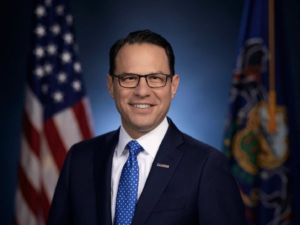Governor’s 2023-2024 Budget Proposal

On March 7th Gov. Josh Shapiro delivered his first Budget Address, outlining key public policy priorities and summarizing his proposed budget for the fiscal year beginning July 1, 2023. The PA Chamber of Business & Industry has reviewed the proposal and summarized its contents, highlighting those items of particular relevance to the broader employer community. They are:
Budget Proposal Overview
Total proposed spending is $44.4 billion, which represents an 8 percent (or $3.3 billion) increase over last year. This does not include over $930 million for the State Police the governor proposes moving to a new fund. Including these funds would bring the year-over-year increase to over 10 percent.
Proposed Changes in PA Tax Structure

Governor Shapiro released his 2023-2024 budget proposal.
The governor noted the bi-partisan efforts last session to phase down the Corporate Net Income Tax (CNI) from 9.99 percent to 4.99 percent by 2031, and said that “while the work that you began is critically important, we need to speed up these cuts.” While his budget document does not reflect an accelerated phase-down of the CNI, he asked the legislature “to work to together to do just that.”
The governor called for a refundable tax credit program for newly certified nurses, police, and teachers equal to $2,500 per year for three years to attract and retain workers in these fields.
While he called for eliminating the sales tax and gross receipts tax on cell phones, which would save $62 million, he also called for increasing the 911 surcharge from $1.65 to $2.03, which would generate an additional $54 million.
He also called for an increase in the income limit for Property Tax Rent Rebates from $35,000 or less for homeowners and $15,000 or less for renters to $45,000 or less for both, which would expand the program to an additional 173,000 seniors and persons with disabilities. The income limits would also be indexed for inflation.
Public Safety and Transportation Funding
The governor proposed establishing a roughly $1 billion new fund for the State Police, funded through existing General Fund revenue sources. In doing so, the governor would also reduce the amount of motor license fund money going to support the State Police by $100 million a year, until it is eliminated in FY2027-28. According to the Governor’s proposal, this provides for the full matching requirements over the next five years for additional federal funding for highways and bridges made available by the bipartisan Infrastructure Investment and Jobs Act and will allow PennDOT to bid $2.5 billion of work each of the next five years. The Governor’s proposal does not contemplate any changes to the structure of the state’s tax on sales of motor fuels.
Permitting Reform
The Governor is requesting additional funding to support staffing and operations of his one-stop shop for permitting key projects, the Governor’s Office of Transformation and Opportunity. The Governor also noted in his remarks that the permitting process takes too long, and that he is charging agencies to define by May 1 expected responses times for all permits to establish a “money back guarantee” if a decision is not made by then. The Governor is also seeking increased funding for DEP and DCNR to hire more permitting staff as well as to develop modeling for carbon capture sequestration in support of securing federal funding for a hydrogen hub in the state.
Education Spending
Total PreK-12 education spending would increase by almost $900 million or 5.6 percent. That includes a $567 million increase in basic education funding, an 8 percent increase, as well as a $104 million increase for special education, a new $100 million block grant to provide mental health services in schools, and a new $100 million grant program for school environmental improvement capital projects.
Higher Education would receive a $60 million increase with a 7.1 percent increase for Penn State, Pitt, Temple and Lincoln Universities and a 2 percent increase for the State System of Higher Education, the Thaddeus Stevens College of Technology, and community colleges.
Workforce Development
Increased funding for existing workforce development programs, including a $14 million, or 13.3 percent, increase for career and technical education and a $2.5 million increase to the apprenticeship training program through the Department of Labor and Industry (L&I). He also proposed two new programs. A $3 million appropriation to the Foundations in Industry program through the Department of Community and Economic Development would increase apprenticeship and pre-apprenticeship programs and a $3.5 million appropriation to the Schools-to-Work program through L&I would support partnerships between career and technical education students and employers.
Proposed Mandated Minimum Wage Increase
Increases the minimum wage from $7.25 to $15/hour effective January 1, 2024. The proposal does not include any other detail, including any references to the tip credit.
Recreational Marijuana
Legalizes adult use cannabis and assessing a 20 percent wholesale tax, which he projects would generate $28 million in the first year, increasing to $250 million by FY2027-28.
Labor Law Compliance
Increases funding by $1.28 million to hire additional labor law compliance investigators within the Department of Labor and Industry to investigate more cases, allow for more strategic enforcement of current laws, and provide additional education for businesses.
Unemployment Compensation
Reauthorizes the Service and Infrastructure Improvement Fund (SIIF), which was established in 2013 and provided for a temporary diversion of employee taxes in order to fund technology infrastructure upgrades. This new authorization is intended to fund 50 new UC Service Center positions.
